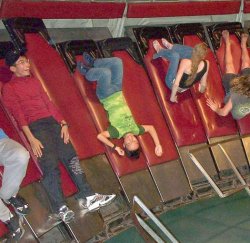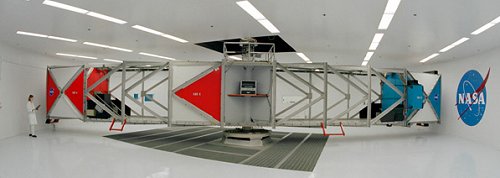|
Researchers are studying the strange effects
of artificial gravity on humans.
by Karen Miller
Want to know what 3-g feels
like?
Go to a carnival.
There's a circular ride there that
spins dizzyingly fast. Standing inside it, your back is pressed
against the wall. It spins faster and faster until, suddenly, the
floor falls away. But you don't fall with it. You remain in place,
pinned to the wall by forces "as great as 3-g - or three
times the normal force of gravity," says Malcolm Cohen, chief of
the Human Information Processing Research Branch at NASA Ames.
During the past few summers, Cohen
has been spinning research subjects in something far more impressive
than a carnival ride. He's been studying engineers, mountain climbers,
teachers and other paid volunteers as they live for up to 22 hours
in a giant, 58-foot diameter centrifuge. His goal? To learn how
humans adjust to changes in gravity - particularly strong gravity.
NASA is interested because it's not
just microgravity that astronauts experience in space. They're exposed
to hypergravity, too: up to 3.2-g at launch, and about 1.4-g
on re-entry. "Under these conditions," Cohen points out, "fluid
weighs more." The heart has to change the way it operates, pumping
faster, and working harder to push the blood all the way to the
brain. This could cause astronauts to become dizzy or even, in extreme
cases, to pass out.
By spinning people in his centrifuge,
Cohen hopes to learn whether the heart's response can be conditioned.
Perhaps if astronauts were exposed to controlled doses of hypergravity
before launch or reentry, then they might be able to tolerate high
g forces better than they otherwise would have.

Image credit and copyright: David Burton
Teenagers
are pinned to the wall inside a spinning carnival ride called
"the Gravitron."
|
An easier ride to space is not the
only potential benefit. Here on Earth, hypergravity could be used
to train athletes, providing an environment in which exercises could
be conducted with more benefit in shorter time. People who suffer
from muscle atrophy might be exposed to it, to stress their muscles
more effectively.
Centrifuges could be key to long-term
space travel, too. That's because microgravity causes the body to
deteriorate in a multitude of ways: cardiovascular deconditioning,
loss of muscle mass, loss of bone density, and a host of other problems.
Artificial gravity could prevent all that - and centrifuges are one
plausible way to generate artificial gravity.
The participants in Cohen's study have
to be less than 5'8" tall - that's because the outer dimensions of
the centrifuge cabin are only 7'7" deep by 5'11" wide. "With its
padded walls, the subjects barely have enough room to lie down on
the cabin's built-in cot," he explains. The cramped cabin is outfitted
with a toilet, a TV, and a laptop loaded with computer games, tests
and questionnaires. While they're spinning, participants answer
questions about stress, fatigue and motion sickness; they perform
complex reasoning tasks; and their vital signs, head movements,
and general activity are monitored by sensors and cameras.
"Artificial gravity is a potentially
useful tool," notes Cohen, "but it's not a universal panacea." The
force generated by a spinning centrifuge is not exactly the same
as gravity, he explains. If you have a small centrifuge - say, one
that might fit in a spaceship - you have to spin it pretty fast
to create g levels high enough to be effective. But there's
a problem: across the radius of a small centrifuge, g levels
change rapidly. "Suppose you're lying on a short-radius centrifuge,
with your head near the centre, and your feet at the outside, and
suppose you have 1-g at your feet. Your head would feel only
about 0.2-g, or even less." That's not quite what you would
experience in Earth's gravitational field!

more
The 20-g
centrifuge at NASA Ames. Cohen uses this device on humans,
exposing them to artificial gravity levels as high as 2-g.
A medical monitoring system and additional safety features
permit human studies from 1 to 12.5-g.
|
Rapid spinning creates another concern: if you move your head too
quickly while you're inside a fast-moving centrifuge, you might
feel uncomfortably like you're tumbling head over heels. This can
happen when balance-sensing fluids in the semicircular canals of
your inner ear become "confused." Some experiments using centrifuges
often include devices that fix the subjects' heads in place, just
to prevent that illusion. Travelling through space, however, with
your head fixed in place is not practical.
Cohen ticks off ways to make centrifugal gravity
feasible:
Perhaps engineers could develop a centrifuge
with a radius of several kilometres, large enough to generate high
artificial gravity without rotating fast enough to trigger the tumbling
illusion. Rather than using small onboard centrifuges, space travelers
might slowly rotate their entire spaceships instead.

The anatomy
of the inner ear. Fluids in the semicircular canals are
crucial to human
balance.
|
Alternately, perhaps subjects could be taught
to adapt to a rotating environment. The brain is unaccountably good
at interpreting strange sensations after they're been around for
a while. Witness the way astronauts can be disoriented when they
first arrive in space, but soon learn to function in a weightless
environment. If humans are spun for long enough, says Cohen, the
strange effects of rotation might become familiar.
For now, though, Cohen is still trying to determine
how different kinds of activities done in hypergravity affect cardiovascular
conditioning. Cohen found that his centrifuge riders spent a lot
of time lying down, in part because it was more comfortable, and
in part because spinning made them drowsy - an effect called "the
sopite syndrome." Cohen noted that he was surprised at how strong
it was. Going forward, he'd like to examine what happens when they
perform a range of predetermined activities, such as standing, in
which the g-force places more stress on the heart.
Much more research remains to be done. "There
are so many options for how best to implement hypergravity most
effectively," says Cohen. "Low intensity for long durations, high
intensity for short durations, short radius centrifuges, rotating
an entire spaceship." We know a lot, he says, but there's much more
to learn. It is, after all, a weighty subject.
|
